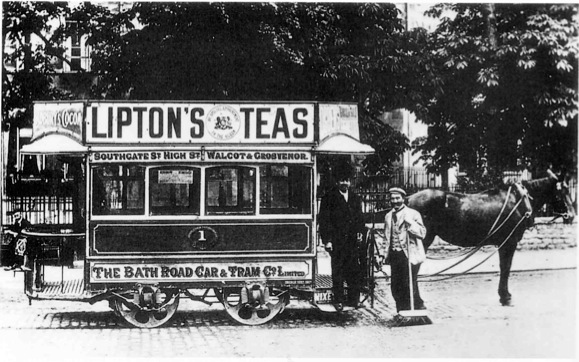Bath Horse Tramways
History
Bath's tramway story started in 1880 when the Bristol Tramways Company Limited approached Bath Corporation with a proposal to build a tramway in the town; this resulted in the formation of the Bath Tramways Company Limited, whose secretary was George White (later Sir), a Bristol entrepreneur and a leading figure in the BTCoLtd. The gauge chosen was 4ft 0ins, with horse-drawn services commencing on the 24th December 1880. The system was essentially a single line, 1.7 miles long, running from the GWR station in the south of the city, northwards then northeastwards to the terminus at Grosvenor College.
Although passenger numbers were initially very promising, they quickly tailed off, and by 1882, the company was struggling to pay the interest on its debentures, let alone a dividend. In 1884, the shareholders had had enough, and the concern was sold to the Patent Cable Tramway Corporation on the 26th of May that year. The PCTC, despite the name, never operated cable trams in Bath, and it too struggled to make the tramway pay its way, a situation that ended in 1888 in liquidation.
The assets of the PCTC were acquired by Dick Kerr & Co — a Glasgow-based engineering company, which became a major player in the British tramway industry — on the 11th August 1888. The Bath Tramways were however soon sold on — on the 1st April 1889 — to the Bath Road Car and Tramways Company Ltd. The new owners quickly put the system in order and were able, unlike their predecessors, to significantly increase passenger numbers and pay consistently good dividends.
By 1898, the corporation had decided that further tramway development would be under municipal control, and to this end, it successfully applied for powers to construct a standard-gauge electric tramway system. As a precursor to conversion, the corporation purchased the tramway in July 1902, the last horse tram running on the 25th of that month, which was probably the date that the company's assets were handed over to the corporation.
Uniforms
Photographs of the horse tramway are relatively rare, but those that do exist suggest that staff working for the first operator — the Bath Tramways Company — were required to turn out in a collar, tie and jacket, the latter more than likely informal (i.e., not issued by the company). Although kepi-style caps were worn, these appear not to have carried a badge.
A photograph (not shown) that was taken during the tenure of the Patent Cable Tramway Corporation however, clearly shows both conductors and drivers wearing smart uniforms. Conductors were provided with single-breasted jackets with stand-up collars, with drivers getting longer double-breasted topcoats with lapels; both garments were piped in a contrasting colour, though whether they bore any insignia remains unknown. Two types of cap appear to have been worn, drooping peak caps (for conductors) and soft-top peaked caps (for drivers); the caps certainly bore a cap badge, though no details can be made out on the surviving photograph. Conductors also wore a bandolier-like cash-bag strap, diagonally across one shoulder. These uniforms were virtually identical to those used on the Highgate Hill Tramways between 1884 and 1888, the connection being the PCTCo, which not only constructed the cable-hauled tramway, but was also intimately involved in the companies set up to operate it.
Following the takeover by the Bath Road Car and Tramways Company (in 1889), uniforms were not issued, conductors (only) wearing kepi-style caps.
Further reading
For a history of the tramway, see: 'Bath Tramways' (Locomotion Papers No 52) by Colin Magg; Oakwood Press (1971).
Images
Horse tram drivers and conductors
An informal photograph of staff of the Bath Tramways Company taken outside the Porter Butt Hotel on 3rd September 1881. Photo courtesy of the Tramways and Light Railway Society, with thanks to David Voice.
An enlargement of the above photograph showing a group of drivers and conductors, the latter with cash-bag straps. All are wearing shirts, ties and jackets (probably not standard), and kepi-style caps; no insignia of any kind is evident, either on the jackets or the caps. Photo courtesy of the Tramways and Light Railway Society, with thanks to David Voice.
Twelve-seater Horsecar No 1 at Grosvenor — photo purportedly taken around 1900, but definitely after the take-over of the Bath Roadcar and Tramways Co Ltd in 1889. The driver appears to be wearing informal attire, including a bowler hat. Photo courtesy of the Tramways and Light Railway Society, with thanks to David Voice.